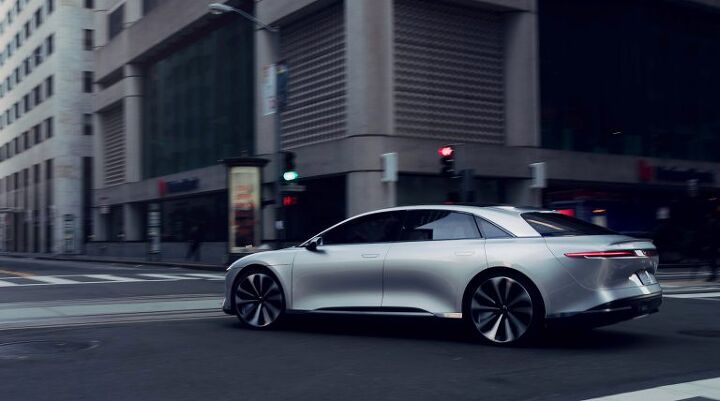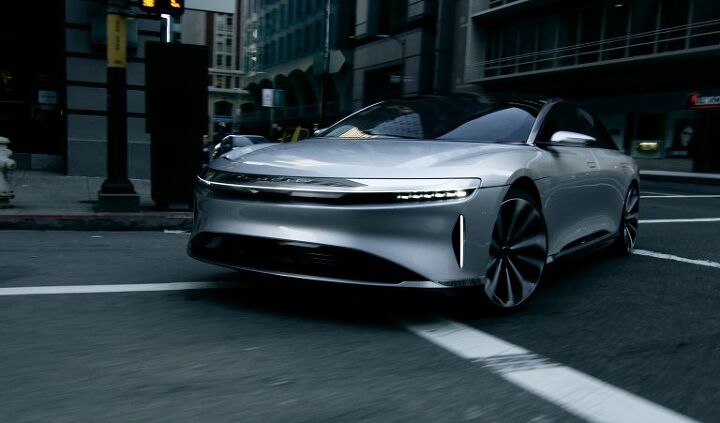Clearing the Air: Lucid Motors Base Sedan Starts at $52,500, Unless You Still Need 1,000 Horsepower

Lucid Motors’ production EV turned out to be a much more reasonable entry than anyone expected. The media buzz was that LM’s Air would be a super-sedan offering up to 1,000 horsepower and a 400 mile range — a real Tesla killer. With a 1,000 horses and instantaneous torque, it would actually shame just about everything else on the road, regardless of how it was powered. However, as is so often the case with EV startups, the reality is significantly more nuanced than the hype.
That doesn’t mean Lucid can’t be a massive thorn in Tesla’s side, though. Looking over the freshly released details of the Air reveals a highly competitive base model (on paper) and, since this is the base model, there remains room for that ludicrously powerful and extravagantly priced car we were promised.
In the interim, consumers will just have to be satisfied with a much more affordable unit, but it still outdoes the base model Tesla in terms of power, range, and price.
Until the Model 3 comes to market, Tesla’s cheapest offering is the $68,000 Model S 60, which is essentially a digitally neutered Model S 75. Lucid Motors’ said its Air will begin at $52,500, after accounting for the federal tax credits available to those purchasing battery electric vehicles. For the money, shoppers get rear-wheel drive and 400 electric ponies to the Model S’ 360.
The all-important maximum range is superior, too. While the Model S 60 is theoretically capable of more if you pay the extra money to unlock it, the base BEV is only rated for 210 miles between charges. Lucid claims its car can manage 240 without needing to be juiced again. That’s not earth shattering by today’s standards, but it’s serviceable and another small victory for the electrified newcomer over America’s current BEV golden boy.
However, these aren’t the gargantuan numbers or price tag were were we expected. What exactly happened?
Lucid’s marketing director, Zak Edson, explains the “confusion” as the result of the press car being a better-equipped example.
“The car that we have been showing publicly represents a well-optioned Lucid Air, leading to confusion regarding the price range. Much of the speculation suggests that the starting price of the car will be over $100,000, which is not accurate,” Edson said.
Marketing magic, basically. Lucid Motors’ knew the press would be more interested in a 1,000 hp hyper-sedan, alluded to it heavily, and then didn’t bother to correct anyone. That said, the company didn’t make the press into liars, either. Edson did specify that the Air would come with 315 and 400 mile range battery options, as well as a 1,000 horsepower twin-motor configuration with all-wheel drive. Those options will be available at launch, and the price of that trim will surpass $100,000. By how much it’ll go past that six-figure amount is anyone’s guess.
A lot of that final sum will be dependent upon how the company decides to price the optional extras, some of which are downright extravagant. While the base model will have an impressive level of connectivity and all the hardware necessary for autonomous driving, features like a glass-canopy roof and reclinable executive rear-seating with massage functions will have to be tacked on to the premium trims. However it’s handled, as long as Lucid doesn’t follow in the footsteps of Faraday Future or make a nicely equipped Air prohibitively expensive, it looks like we’ll get that potential “Tesla Killer™” after all.
[Images: Lucid Motors]

A staunch consumer advocate tracking industry trends and regulation. Before joining TTAC, Matt spent a decade working for marketing and research firms based in NYC. Clients included several of the world’s largest automakers, global tire brands, and aftermarket part suppliers. Dissatisfied with the corporate world and resentful of having to wear suits everyday, he pivoted to writing about cars. Since then, that man has become an ardent supporter of the right-to-repair movement, been interviewed on the auto industry by national radio broadcasts, driven more rental cars than anyone ever should, participated in amateur rallying events, and received the requisite minimum training as sanctioned by the SCCA. Handy with a wrench, Matt grew up surrounded by Detroit auto workers and managed to get a pizza delivery job before he was legally eligible. He later found himself driving box trucks through Manhattan, guaranteeing future sympathy for actual truckers. He continues to conduct research pertaining to the automotive sector as an independent contractor and has since moved back to his native Michigan, closer to where the cars are born. A contrarian, Matt claims to prefer understeer — stating that front and all-wheel drive vehicles cater best to his driving style.
More by Matt Posky
Latest Car Reviews
Read moreLatest Product Reviews
Read moreRecent Comments
- Spectator This was an amazing vehicle. Back then Acura knew how to make a plush and comfy seat!
- Syke F1 fan and normally watch every race, although most of them are DVR'd. I've got my Xfinity box set up to record everything automatically. This past Sunday I watched the race live for a change.
- Jalop1991 There is no inflation. Everything is cheaper than it was 5 years ago. SHRIMP AND GRITS!
- ChristianWimmer Exterior and interior look pretty flawless for such a high mileage car. To me this is an indication that it was well-maintained and driven responsibly. It’s not my cup of tea but it’s bound to find an enthusiastic owner out there.And with ANY car, always budget for maintenance.
- Fred I'm a fan and watch every race. I've missed a few of the live races, but ESPN repeats them during more reasonable hours.





































Comments
Join the conversation
The real question in my mind isn't about the drivetrain, but about whether the rest of the car holds up to This Is Actually A Good Car standards. The Model S doesn't. Will the windows rattle when you shut the doors? The Tesla's do. Does the wind whistle and thrum at highway speed? It does in the Tesla. Will the interior look nice but feel hollow, like a movie set? The Tesla's does. Will the ergonomics be horribly compromised in favor of an abstract goal? The Tesla's are. Will the sharp edges of the door handles rub you the wrong way as they flex and wobble? The Tesla's do. Building an electric car isn't a huge issue these days, it seems. But building an actual vehicle that holds up to the not terribly high standards set by any Accord or Sonata or (mostly) Fusion seems to be much more difficult, and until EV makers crack that nut, they're going to find their markets limited to people who buy based on idealism. That's enough for Tesla right now. I doubt it will be enough for all of them in 10 years.
The price is right. But man is the styling crap. The front end looks like a 1990 Celica. Hello, 2000 called and want their beaded LED DRLs back. The back looks like a Buick and some other car that I can't think of off the top of my head.